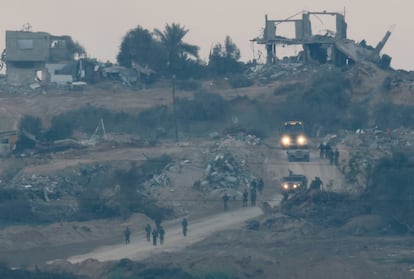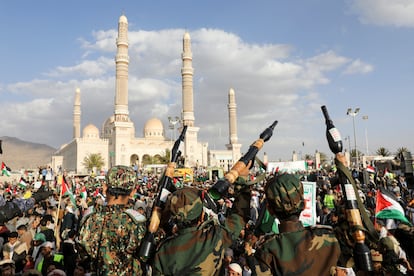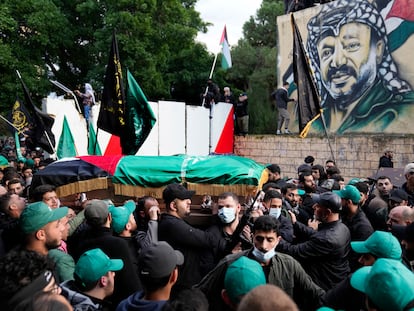Danger of Gaza war spillover peaks in Middle East after three months of fighting
Tension are high following the attacks between Israel and Hezbollah on the Lebanese border and by Houthi militants in the Red Sea. U.S. Secretary of State Antony Blinken has called on countries in the region to ‘de-escalate’ the conflict


The war in the Gaza Strip has reached a dangerous peak of regional expansion that threatens to spread hostilities throughout the Middle East. Three months have passed since the start of the conflict, marked by the death of more than 22,000 Palestinians and 1,200 Israelis, as well as the destruction of Gaza and the displacement of 90% of its 2.3 million inhabitants. Now, there are fears the conflict could spread to southern Lebanon after the assassination of Hamas deputy leader Saleh al-Aruri on Tuesday, and the closure of the strategic Red Sea route due to the attacks by Yemen’s Houthis on merchant ships.
After four days of relative containment, Hezbollah — considered the most powerful paramilitary organization in the Middle East — fired more than 60 rockets from southern Lebanon early Saturday morning at an Israeli military intelligence observation post in Meron, as well as against other border areas in Metula and Margaliot. It was one of the most intense strike since the start of the war in Gaza, following the Hamas attacks on October 7.
The pro-Iranian militia party defined the rocket barrage as a “preliminary response” to the death of Hamas’ second-in-command in a drone attack in Beirut. Hezbollah has accused Israel of the apparent selective strike, committed in one of the Shiite strongholds of the Lebanese capital, but the Israeli government of Benjamin Netanyahu has not claimed responsibility for the action, which bears the stamp of the Israeli intelligence services. Hezbollah’s leader, Shiite cleric Hasan Nasrallah, warned on Friday the attack on Al-Aruri would not go “unanswered.” Since October 7, he claims to have ordered 670 operations against Israel.
In response to the Hezbollah attack on Saturday, the Israeli army launched artillery and drone attacks against Shiite militia positions in southern Lebanon where the rocket launch pads were located. This was Israel’s usual response, despite the large number of rockets fired. However, a few hours later, the Israeli Defense Forces (IDF) launched ground and air attacks against various Hezbollah positions in Ayta ash-Shab, Yaroun and Ramyah in southern Lebanon, according to a military statement.
On Friday, IDF spokesman Rear Adm. Daniel Hagari said that Israel was in a “very high state of alert” on the border of Lebanon, and made reference to the 2006 Lebanon war, which killed 1,300 Lebanese, mostly civilians, and 165 Israelis, almost all soldiers, in 33 days of fighting. Subsequently, 10,800 U.N. blue helmets from 40 countries were deployed to the border.
U.S. Secretary of State, Antony Blinken and the High Representative of the EU for Foreign Policy and Security, Josep Borrell, both called on Saturday for the conflict to be contained. During his visit to Greece, Blinken stated that Israel “does not want escalation... but they also have to be fully prepared to defend themselves,” in reference to the attacks by Hezbollah and Hamas. He also said that Turkey was prepared to use the relations it has with the critical actors in the region to de-escalate the conflict. “We want to make sure that countries who feel that way are also using their ties, using their influence, using their relationships with some of the actors that might be involved to keep a lid on things, to make sure that we’re not seeing the spread of conflict,” he said before flying to Jordan, as quoted by Reuters.
Meanwhile, Borrell told reporters in Beirut that “it is imperative to avoid a regional escalation in the Middle East, it is absolutely necessary to avoid Lebanon being dragged into a regional conflict,” according to Spanish news agency Efe. He also sent a message to Israel: no one will emerge victorious from a regional conflict. “Even war has laws, and there are international humanitarian laws that have to be respected. As I said many times; one horror does not justify another [one],” he said in a press conference alongside Lebanese Foreign Minister Abdallah Bou Habib. “There must be another way to eradicate Hamas; another way that [does not] creates so many innocent people being killed.”
According to Israeli analyst Daniel Kupervaser, no side wants the attacks in the northern front to turn into a regional conflict. “They are concerned about showing their presence on the ground, but they are avoiding overreaching,” he points out. He sees Saturday’s exchange of attacks as a good example. “Hezbollah claimed it was retaliation for the killing of Al-Aruri,” explains Kupervaser, “knowing that their rockets were not going to cause significant damage.” Other actors also operate on the northern front, such as Palestinian militias exiled in Lebanon, affiliated with both Hamas and the secular nationalist Fatah party.
Since the beginning of hostilities in Gaza, at least 177 deaths have been recorded on the Lebanese border front: 13 in Israel (nine soldiers and four civilians) and 164 in Lebanon (127 members of Hezbollah, 16 members of Palestinian militias, a Lebanese soldier and 20 civilians, including three journalists), according to Efe. Israel has deployed more than 200,000 troops to its northern border, where more than 80,000 people have been evacuated due to hostilities. On the Lebanese side of the border, more than 70,000 civilians have been displaced from their homes.
According to Amos Harel, defense correspondent for the newspaper Haaretz, Netanyahu’s decision to evacuate the towns closest to the Lebanese border, including Kiryat Shmona (60,000 inhabitants), which were later occupied by soldiers, allowed them to be attacked by Hezbollah, which considered them military targets. “The exchanges of fire in the present format [of relative intensity] could last for some months, during which the Americans and the French will attempt to achieve a diplomatic settlement,” he wrote in an article on Friday. “This is without noting the possibility that a tough response by Hezbollah to Arouri’s death will set the sides on a track of miscalculations that will engender sharp escalation.”
Netanyahu refuses ceasefire
Amid the usual instability that plagues the Middle East, famine is looming inexorably over hundreds of thousands of civilians crowded together in the southern Gaza Strip. Malnutrition and disease will decimate the child population if not urgently remedied. But no ceasefire is in sight. Netanyahu said Saturday night that he will not end the war until “all objectives are achieved.” “Three months ago, Hamas committed a terrible massacre,” he said in a statement, “the government ordered the army to go to war to eliminate Hamas, take back our hostages and ensure that Gaza will never again pose a threat to Israel.” The prime minister warned that there will be no immunity for Hamas.
Despite Netanyahu’s ardor for war, the IDF have entered the so-called Phase 3 of the war, which involves the demobilization of the reservist units that have fought in Gaza and an operations strategy focused on very specific objectives. Late on Saturday, IDF spokesman Hagari said that the Israeli army had completed the dismantling of the “military framework” in northern Gaza and was now focusing its operations in the center and south of Gaza. Gazans, meanwhile, continue to die in a war that is on track to exceed 100 days. At least 122 people lost their lives between midday Friday and Saturday, according to data released by the Gaza’s Ministry of Health, which is controlled by Hamas. Most of the victims were women and children.
Until the release of the 136 hostages still held by Hamas in Gaza, presumably in exchange for the release of hundreds of Palestinian prisoners charged with “security offenses,” Israel will not end hostilities or allow the mass return of displaced persons to their homes — or what remains of them — in the north of the Gaza Strip. In the three months of the war, 175 Israeli soldiers have been killed in combat, while Israel claims it has killed 8,000 Hamas militiamen.
Benny Gantz, former Israeli Minister of Defense and a member of the emergency government formed for the war, recognized two months ago that his country is fighting a “multi-front war.” “We are fighting both in the north and in the south,” warned Gantz, who led the previous large-scale conflict in the Palestinian strip in 2014 as general chief of staff.
The attacks against Israel, mostly by militias and armed groups associated with Iran, extend from the borders of Lebanon and Syria to the Red Sea. On this southern front, Mohammed Ali al-Houthi, the head of Yemen’s Houthi supreme revolutionary committee, told the BBC on Friday that any country that is involved in the U.S-led international coalition in the Red Sea will lose its maritime security and be targeted. The main international shipping companies are already avoiding passage through the Red Sea towards the Suez Canal and have been forced to follow longer routes bordering Africa.

Since last November, Yemeni rebels have launched attacks on ships bound for Israel or with Israeli owners. They have also attacked the southern tip of Israeli territory: the port city of Eilat on the Gulf of Aqaba, where the Jewish state has an outlet to the Red Sea. The launch of suicide drones and cruise and ballistic missiles from Yemen has redoubled the threat of pro-Iranian forces against Israel, which is using the new Arrow missile defense system to protect itself. This is the most advanced rocket shield it has at its disposal.
“We are facing a new type of multifront war,” Yossi Kuperwasser, who was head of the intelligence research division of the IDF, recently stated. This analyst believes that Iran’s allies have been exerting more pressure as part of “a simultaneous operation of the Shiite forces.”
Sign up for our weekly newsletter to get more English-language news coverage from EL PAÍS USA Edition
Tu suscripción se está usando en otro dispositivo
¿Quieres añadir otro usuario a tu suscripción?
Si continúas leyendo en este dispositivo, no se podrá leer en el otro.
FlechaTu suscripción se está usando en otro dispositivo y solo puedes acceder a EL PAÍS desde un dispositivo a la vez.
Si quieres compartir tu cuenta, cambia tu suscripción a la modalidad Premium, así podrás añadir otro usuario. Cada uno accederá con su propia cuenta de email, lo que os permitirá personalizar vuestra experiencia en EL PAÍS.
¿Tienes una suscripción de empresa? Accede aquí para contratar más cuentas.
En el caso de no saber quién está usando tu cuenta, te recomendamos cambiar tu contraseña aquí.
Si decides continuar compartiendo tu cuenta, este mensaje se mostrará en tu dispositivo y en el de la otra persona que está usando tu cuenta de forma indefinida, afectando a tu experiencia de lectura. Puedes consultar aquí los términos y condiciones de la suscripción digital.
More information

Israel warns US time is running out to prevent war from spreading to Lebanon
Archived In
Últimas noticias
Welcome to the post-religion era: The idea of Christianity as the absolute truth has become obsolete
‘I thought you would like it’: The risky sexual practice popularized by TV shows and TikTok
The digitalization of tourism: ‘They promise experiences and gave us the worst possible one’
Mexican peso defies uncertainty with forecasts of a new period of stability in 2026
Most viewed
- Sinaloa Cartel war is taking its toll on Los Chapitos
- Oona Chaplin: ‘I told James Cameron that I was living in a treehouse and starting a permaculture project with a friend’
- Reinhard Genzel, Nobel laureate in physics: ‘One-minute videos will never give you the truth’
- Why the price of coffee has skyrocketed: from Brazilian plantations to specialty coffee houses
- Silver prices are going crazy: This is what’s fueling the rally









































